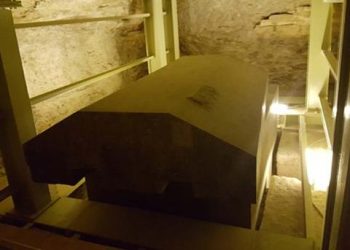Skara Brae
In 1850, a fierce storm on the Orkney Islands unearthed the hidden wonders of Skara Brae, often referred to as the ‘Scottish Pompeii‘. This remarkable Neolithic village, dating back to 3200 BC, lay concealed under sand for millennia, providing a pristine snapshot of prehistoric life. Its discovery marked a pivotal moment in understanding Britain’s ancient history. The well-preserved structures and artifacts of Skara Brae offer insights into the daily lives of a people who were among the first to erect stone circles in Britain. Intriguingly, the lineage of Skara Brae’s inhabitants mysteriously disappeared from the genetic record, yet their architectural legacy continued, culminating in the creation of Stonehenge, a prehistoric monument that has captivated the world.
The residents of Skara Brae demonstrated exceptional architectural skills, far surpassing the typical Neolithic standards. In an era dominated by basic shelters, they built complex stone structures featuring distinct rooms, stone furniture, and sophisticated drainage systems. This level of advancement begs the question: How did such knowledge come to be, and what influenced these early builders? The architectural sophistication of Skara Brae’s inhabitants significantly impacted the development of later megalithic structures across Britain, suggesting a continuous evolution of architectural and astronomical knowledge.
The Stones of Stenness: Astronomical Alignment and Ancient Mysteries
The Stones of Stenness, located a short distance from Skara Brae, represent another monumental achievement of Neolithic Britain. This stone circle, comprising towering megaliths arranged in a precise circular formation, exhibits a deliberate astronomical alignment. The positioning of the stones in relation to the Orion and Cygnus constellations mirrors the alignments found in faraway sites like Göbekli Tepe. This suggests a profound understanding of the cosmos, shared across vast distances and cultures, and raises questions about the transmission of astronomical knowledge in the ancient world.

Stonehenge, often perceived as an elaborate ancient calendar, embodies a complexity that hints at a deeper significance. The meticulous arrangement of its massive stones, in alignment with celestial events such as solstices and equinoxes, goes beyond simple timekeeping. Scholars and researchers speculate that Stonehenge and similar structures might have played roles in ritualistic practices or served as markers for significant astronomical events. Some theories even suggest that these megaliths were part of a larger ancient technology system, possibly related to harnessing natural energies or geo-electrical phenomena, a concept far ahead of its time.
Ancient Energy and Geo-Electrical Theories
Emerging theories propose that Stonehenge and other megalithic sites were not merely ritualistic or ceremonial in nature but may have functioned as ancient technological hubs. As per experts, these structures, aligned with precise astrological configurations, could have been designed to tap into and manipulate natural geo-electrical forces for unknown purposes. This perspective reimagines Stonehenge and its counterparts as components of a sophisticated network of prehistoric engineering, potentially inspired by ancient civilizations like those responsible for Göbekli Tepe, suggesting a global exchange of advanced knowledge in the ancient world.
The connection between Skara Brae and Stonehenge offers a fascinating glimpse into the depth and complexity of Britain’s prehistoric past. These ancient sites, with their enduring mysteries and potential technological purposes, continue to captivate and challenge our understanding of early human civilizations. As we explore these enigmatic structures, they stand as enduring symbols of ancient innovation and a testament to the ingenuity of our distant ancestors.











